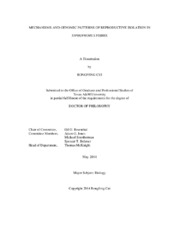| dc.description.abstract | Learned mate choice has a fundamental role in population dynamics and speciation. Social learning plays a ubiquitous role in shaping how individuals make decisions. Learning does not act on a blank slate, however, and responses to social experience depend on interactions with genetically-specified substrates – the so-called “instinct to learn”. I develop a new software Admixsimul, which allows forward-time simulations of neutral SNP markers and functional loci, mapped to user-defined
genomes with user-specified functions that allow for complex dominance and epistatic effects. Complex natural and sexual selection regimes (including indirect genetic effects) are available through user-defined, arbitrary fitness and mate-choice probability functions. Using simulation, I show that responses to learned stimuli can evolve to opposite extremes in the context of mating decisions, with choosers either preferring or avoiding familiar social stimuli, depending on the relative importance of inbreeding avoidance versus conspecific mate recognition. I also show that under certain scenarios, learned preference is sufficient to maintain reproductive isolation during secondary
contact. Two sister species of swordtail fish have evolved such opposite responses to
learned social stimuli. The interaction of learned and innate inputs in structuring mate-choice
decisions can explain variation in genetic admixture in natural populations. Olfactory preference of X. malinche females is affected by previous experience with adult cues. I compare gene expression levels of transcriptome libraries prepared from pooled sensory and brain tissues between 3 treatment groups that differ by social experience. I found genes involved in neural plasticity differentially expressed not only between control and exposure groups, but also between groups exposed to conspecific and heterospecific models. I also found evidence that certain vomeronasal receptor type 2 (V2R) paralogs may detect species-specific pheromone components and show differential expression between treatment groups. I then reconstruct evolutionary relationships among swordtails and platyfishes (Xiphophorus: Poeciliidae). Using genomic data, I resolve a high-confidence species tree of Xiphophorus that accounts for both incomplete lineage sorting and hybridization. The results allow me to re-examine a long-standing controversy about the evolution of the sexually selected sword in Xiphophorus, and demonstrate that hybridization has been strikingly widespread in the evolutionary history of this genus. | en |


